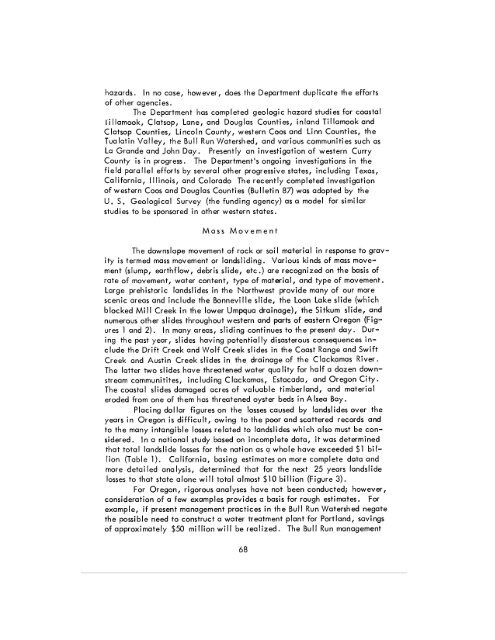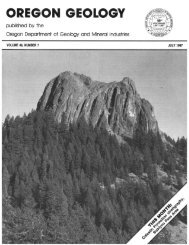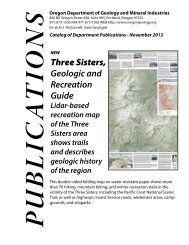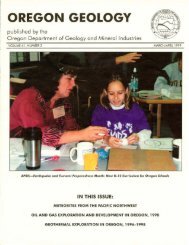The Ore Bin - Oregon Department of Geology and Mineral Industries
The Ore Bin - Oregon Department of Geology and Mineral Industries
The Ore Bin - Oregon Department of Geology and Mineral Industries
You also want an ePaper? Increase the reach of your titles
YUMPU automatically turns print PDFs into web optimized ePapers that Google loves.
hazards. In no case, however, does the <strong>Department</strong> duplicate the efforts<br />
<strong>of</strong> other agencies.<br />
<strong>The</strong> <strong>Department</strong> has completed geologic hazard studies for coastal<br />
lillamook, Clatsop, Lane, <strong>and</strong> Douglas Counties, inl<strong>and</strong> Tillamook <strong>and</strong><br />
Clatsop Counties, Lincoln County, western Coos <strong>and</strong> Linn Counties, the<br />
Tualatin Valley, the Bull Run Watershed, <strong>and</strong> various communities such as<br />
La Gr<strong>and</strong>e <strong>and</strong> John Day. Presently an investigation <strong>of</strong> western Curry<br />
County is in progress. <strong>The</strong> <strong>Department</strong>'s ongoing investigations in the<br />
field parallel efforts by several other progressive states, including Texas,<br />
California, Illinois, <strong>and</strong> Colorado <strong>The</strong> recently completed investigation<br />
<strong>of</strong> western Coos <strong>and</strong> Douglas Counties (Bulletin 87) was adopted by the<br />
U. S. Geological Survey (the funding agency) as a model for similar<br />
studies to be sponsored in other western states.<br />
Mass Movement<br />
<strong>The</strong> downslope movement <strong>of</strong> rock or soil material in response to gravity<br />
is termed mass movement or l<strong>and</strong>sliding. Various kinds <strong>of</strong> mass movement<br />
(slump, earthflow, debris slide, etc.) are recognized on the basis <strong>of</strong><br />
rate <strong>of</strong> movement, water content, type <strong>of</strong> materia I, <strong>and</strong> type <strong>of</strong> movement.<br />
Large prehistoric l<strong>and</strong>slides in the Northwest provide many <strong>of</strong> our more<br />
scenic areas <strong>and</strong> include the Bonnevi lie slide, the Loon Lake slide (which<br />
blocked Mill Creek in the lower Umpqua drainage), the Sitkum slide, <strong>and</strong><br />
numerous other slides throughout western <strong>and</strong> parts <strong>of</strong> eastern <strong>Ore</strong>gon (Figures<br />
1 <strong>and</strong> 2), In many areas, sliding continues to the present day. During<br />
the past year, slides having potentially disasterous consequences include<br />
the Drift Creek <strong>and</strong> Wolf Creek slides in the Coast Range <strong>and</strong> Swift<br />
Creek <strong>and</strong> Austin Creek slides in the drainage <strong>of</strong> the Clackamas River.<br />
<strong>The</strong> latter two slides have threatened water qua lity for half a dozen downstream<br />
communitites, including Clackamas, Estacada, <strong>and</strong> <strong>Ore</strong>gon City.<br />
<strong>The</strong> coastal slides damaged acres <strong>of</strong> valuable timberl<strong>and</strong>, <strong>and</strong> material<br />
eroded from one <strong>of</strong> th em has threatened oyster beds inA Isea Bay.<br />
Placing dollar figures on the losses caused by l<strong>and</strong>slides over the<br />
years in <strong>Ore</strong>gon is difficult, owing to the poor <strong>and</strong> scattered records <strong>and</strong><br />
to the many intangible losses related to l<strong>and</strong>slides which also must be considered,<br />
In a national study based on incomplete data, it was determined<br />
that total l<strong>and</strong>slide losses for the nation as q whole have exceeded $1 billion<br />
(Table 1), California, basing estimates on more complete data <strong>and</strong><br />
more detai led ana lysis, determined that for the next 25 years l<strong>and</strong>slide<br />
losses to that state alone will total almost $10 billion (Figure 3).<br />
For <strong>Ore</strong>gon, rigorous analyses have not been conducted; however,<br />
consideration <strong>of</strong> a few examples provides a basis for rough estimates. For<br />
example, if present management practices in the Bull Run Watershed negate<br />
the possible need to construct a water treatment plant for Portl<strong>and</strong>, savings<br />
<strong>of</strong> approximately $50 million will be realized. <strong>The</strong> Bull Run management<br />
68









